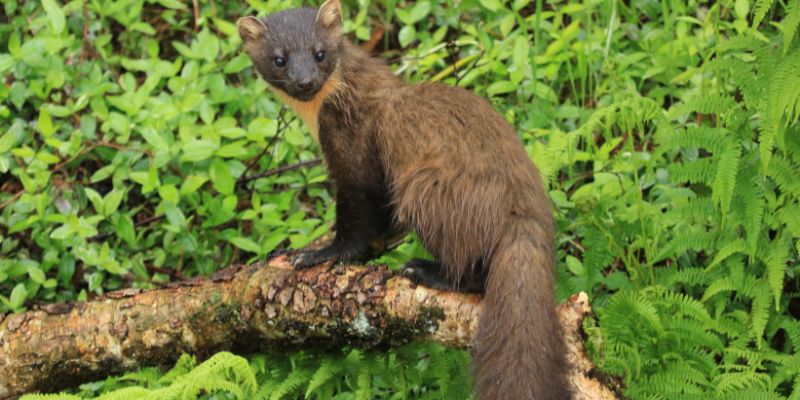
Pine martens have been reintroduced into woodland in South Cumbria thanks to a project involving researchers from the University of Leeds.
The elusive forest dwellers were once widespread in the county, but their numbers gradually reduced over time, and it was assumed that they had disappeared altogether until a rare sighting in 2022 – the first in ten years.
Now a partnership of organisations and landowners led by the University of Cumbria, including the Upper Duddon Landscape Recovery Project led by the University of Leeds, has released 13 healthy adult pine martens (eight females and five males) into Grizedale Forest and the Rusland Valley. The animals were moved recently under licence from strong populations in the Scottish Highlands.
It is exciting to watch their movements as they get used to their new home in the Lake District!
Pine martens are one of the focus species of the Upper Duddon Landscape Recovery Project. The team led by Professor Dominick Spracklen from the School of Earth and Environment has supported the pine marten release project for the last two years with funding and habitat surveys. They also worked with residents and farmers in south Cumbria to assess attitudes to a pine marten reintroduction.
“Our Upper Duddon project team is now helping with monitoring the pine martens as they move around South Cumbria using radio tracking,” said Professor Spracklen.
“They have radio collars on so we can track exactly where they go. We also have camera traps set up, with the permission of landowners, across South Cumbria. It is exciting to watch their movements as they get used to their new home in the Lake District!”

Caption: Students and project volunteers checking camera traps in the release area. Picture courtesy of Dr Mic Mayhew.
Secure breeding sites
This is the first of two releases by the pine marten recovery project, and it is hoped that by returning some of the animals to their ancestral woodland homes, populations will be able to grow. A network of den boxes has been installed throughout the region to provide secure breeding sites for the pine martens next spring.
The habitat surveys and monitoring led by Dr Mic Mayhew from the University of Cumbria found that the best place for a release was Forestry England’s Grizedale Forest and the Graythwaite Estate which are about 10 km from the Duddon Valley.
“Previous reintroductions in Wales and England have found that pine martens can quickly move 10 to 30 km away from the release site. The good connectivity of woodlands in the area means that they might be expected to move quite quickly to other parts of South Cumbria including the Duddon Valley.” said Dr Mayhew.
Habitat restoration
The DEFRA-funded Upper Duddon Landscape Recovery Project is designed to work with farmers and other land managers to manage the land in ways that will improve soil and water quality and reverse the decline in nature.
The work will explore options for habitat restoration of native woodland, wood pasture, heath, scrub, and peat bogs. It will also include the necessary feasibility studies to enable the future restoration of rare native species, including water voles, globeflowers, tree pipits and pine marten, that will help nature thrive and recover, whilst ensuring long-term financial security for the farms.
The team will now be sharing news of the pine martens’ progress with local schools. John Hodgson, the Project Manager for the Upper Duddon project said: “We are proud to support this locally led partnership that has helped to restore pine martens to Cumbria. Pine martens are an important part of the Lake District's natural heritage. It’s great news that they are back!
“We look forward to working with schools across south and west Cumbria and provide opportunities for children to learn about these amazing animals.”
Further information
Top image: a pine marten in the Scottish Highlands in 2022. Picture courtesy of Dr Mic Mayhew from the University of Cumbria.
For media enquiries, please contact Kersti Mitchell via k.mitchell@leeds.ac.uk